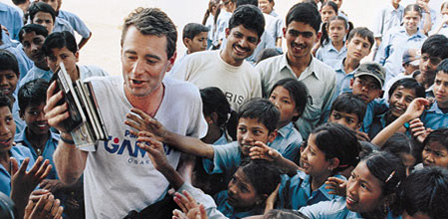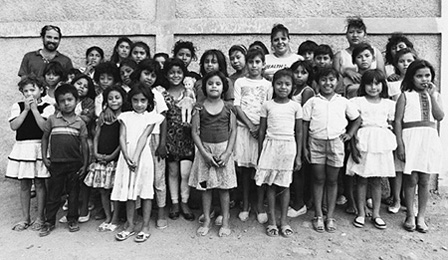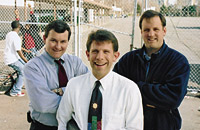 |
|
Room
to Read's John Wood '89 distributing books to eager
readers in Nepal.
|
Sharing
their knowledge
With
their passion for social change and entrepreneurial leadership,
these alums are transforming lives
By
Matt Golosinski
John Wood
didn’t go to Nepal looking for a life-changing experience.
The 1989
Kellogg School graduate says he just needed a break from the
corporate life at Microsoft, where he had worked for seven
years before he started tasting burnout. What began as an
exotic vacation put him face-to-face with the most dire poverty
he had ever seen.
Trekking
through the cold Himalayan mountain passes that took him from
one poor, remote village to another, Wood recalled the words
of his one-time
Kellogg
professor, Gene Lavengood: “To whom much is given, much
is expected.” The lesson hit home as he stared into the
faces of children who rushed up to him as he entered their
communities; children so poor they were beyond asking for
money. They just wanted a pencil.
“These
people were living on a dollar a day — I was amazed at
the lack of resources,” says Wood. “Their schools
were just collections of dead branches, sheet metal and dirt
floors. What they called ‘libraries’ might have
25 books for more than 200 kids, and the books were cast-offs
from trekkers, stuff children would never read.”
Experiences
like this forced Wood into a deeper understanding of Lavengood’s
adage.
“He
wasn’t only talking about sharing material goods, but
about an obligation to make a difference using your intelligence
to help others,” says Wood, who is today the founder
and president of Room To Read, a San Francisco-based nonprofit
organization that advances literacy in Nepal and Vietnam.
In two years of existence, Room To Read has built 15 schools,
150 libraries, shipped more than 90,000 books to needy children
and established 40 long-term scholarships.
“I
get to apply everything I learned at Kellogg to actually build
a nonprofit company, running it in a very business-like, goal-oriented,
efficient manner,” says Wood.
A “nation
of children”
Like
Wood, Kevin Marinacci ’96 had his eyes opened to his
responsibility to help those less fortunate.
As a Georgetown
University student in 1989, Marinacci found himself in a war
zone, or among the embers of a war that hadn’t officially
been declared dead. He had landed in Nicaragua to spend a
year abroad with the school’s volunteer corps. What he
discovered was a nation of children — among them nearly
20,000 orphans. Almost half the population was under the age
of 14 when the civil war ended, he says.
Marinacci
joined a group running an orphanage called Familia Padre Fabretto
(FPF), or “Father Fabretto’s Family,” in northern
Nicaragua. Named after the charismatic Italian missionary,
Father Rafael Fabretto, who began the organization in 1953
and managed it by grit and spit until his death in 1990, FPF
served as a true “safe haven” for kids trapped in
a violent society, says Marinacci.
“After
20 years of war, the country was in shambles,” says the
Kellogg alum, who grew up in Evanston and attended Loyola
Academy, where the Jesuits imparted a message similar to Lavengood’s.
“Teenagers were drummed into military service, either
on the side of the Sandinistas or the contras. To be a kid
in Nicaragua then was really bad.”
The son
of a retired Amoco executive, Marinacci came from a self-described
world of privilege. Though his parents emphasized the value
of charitable service, it would have been easy for Marinacci
to follow his father’s advice —go to business school
and land a corporate job. His Nicaragua stint could have ended
as a college experiment.
Instead,
the experience changed Marinacci’s life. Today he serves
as executive director of the public relations and fundraising
arm of FPF, Fabretto Children’s Foundation (FCF). Marinacci
has expanded the Evanston-based organization’s mission
to include a host of vocational programs serving some 1,200
youth.
 |
| Kevin
Marinacci '96 with some of the Nicaraguan children his
organization serves. |
Teachers
as leaders
Matt
Candler and Mark Medema may not have undergone the dramatic
encounters of Wood and Marinacci. Yet they are just as passionate
about using their leadership training to give back to the
community. Through their roles at San Francisco-based KIPP
(Knowledge Is Power Program), they bring quality education
and resources
to disenfranchised
middle-school kids in urban areas across America.
Both Candler
’98 and Medema ’95 insist that education, coupled
with leadership experience, provides the key to personal development.
Candler, KIPP’s vice president of operations, recalls
the powerful inspiration of his own teachers.
“I
had a history teacher named Joe Tribble in high school, “
says Candler. “I hated history, but soon I was doing
two hours of homework a night. This guy invested so much time
pushing us to excel. To this day I’ve never worked harder
for someone.
“That
was the first time I realized you could have an impact on
the way people think,” adds Candler, who during his Kellogg
career earned one of the school’s “Top Student Awards”
and co-founded the Kellogg Education Club. “A lot of
that has to do with your own effort and willingness to invest
in others.”
This kind
of intellectual — and capital — investment is how
KIPP aims to “force change in the American public school
system from outside that system,” according to Medema,
the organization’s director of school implementation.
Medema and Candler say that true leaders must take the reins
in education, from the schoolhouse up into higher administrative
ranks.
Through
a year-long program called the Fisher Fellowship, KIPP identifies
and invests in exemplary teachers, tagging them as potential
leaders who can juggle a variety of roles. KIPP’s teacher-leaders
must be capable of functioning as the “CEOs of their
own small business” — their school. In addition,
they must be “political animals” who engage their
local municipality to advance change.
KIPP’s
“Five Pillars” for educational excellence include
higher expectations, longer school days, and results-oriented
programming. At the root of these efforts are the teachers
KIPP trains — a project that excites Medema and calls
upon his Kellogg leadership training.
 |
|
KIPP's Candler '98 (left) and Medema '95 (right) with
Andy Schipper, director of Oakland's OAK College Preparatory
School. |
|
| |
|
“One
of the things I learned at Kellogg, in addition to management,
was the importance of leadership. My spark comes from training
these teachers, who are going to be leaders of other nonprofits,”
says Medema, a former urban planner and financier. “What
really drives me is watching these young people take risks
and go out and start a school, to face challenges that are
way over their heads — and beat those challenges.”
Beating
the odds
These
Kellogg alums, in their distinct ways, have taken on an array
of managerial challenges facing the nonprofit sector. Issues
of fundraising, strategy and organizational design are not
unique to nonprofits, but solutions to these hurdles can mean
the difference between life and death — and not simply
for the company.
For example,
one of the most significant initiatives FPF has implemented
may also be its most basic: providing a good daily meal to
children who would otherwise go hungry. “Our after-school
lunch program is essential,” says Marinacci. In his mind,
the program is as important as the organization’s more
obvious architecture: five children’s homes, a 300-acre
farm, a sawmill and forestry projects, and various mechanical
shops to teach vocational skills.
Managing
these programs requires Marinacci to shift between many roles,
from fund raising to program development.
“Nonprofits
are like small ventures: you have to wear a lot of hats,”
he says. One of those hats includes serving as PR chief to
communicate the organization’s mission to others. Marinacci
has done that, even enlisting the managerial expertise of
his father, Carl, the man who expressed some early reservations
about his son’s ambitions.
Today,
Carl is the organization’s president.
“It’s
funny,” says the younger Marinacci. “My dad first
made the trip [to Nicaragua] in 1991. Basically he told me
to get on with my life. Not only did I tell him this was my
life, but he soon caught the nonprofit bug too, once he saw
how much work needed to be done to help these kids.”
John Wood
can relate. He too understands the challenge of enlisting
others to join the cause, and how to get by with less. For
Wood, the transition to Room to Read presented operational
hurdles largely absent in his former senior marketing role.
For starters, Room To Read didn’t have a $25 million
marketing budget to work with, nor did it have the 100-person
staff he oversaw at his old employer. Instead, Wood learned
the value of “painting an effective vision” to engage
the efforts of a legion of volunteers to get the job done.
“Nobody
has to do anything for me now,” says Wood, noting that
Room To Read only has one other full-time staff member. “Yet,
we’ve built this incredible coalition of volunteers who
want to do something to help.”
Wood explains
how important nonprofit leaders are to the fund-raising process.
Proving they can make donors’ contributions stretch further
can mean more resources for the organization.
“I’ve
really had to deploy my powers of persuasion to show people
what we’re able to accomplish — and accomplish by
directing more than 95 percent of
our funds
right into our programs, by keeping administrative costs very
low,” Wood says.
Wood has
convinced some fellow Kellogg School grads of Room To Read’s
worthiness as a nonprofit investment. Among Wood’s supporters
are members of his own Kellogg class. Recently, several 1989
peers pooled their efforts and raised more than $10,000, enough
money to launch several new schools in Nepal. Stuart Kerr
’89 helped spearhead the campaign and points to Wood’s
character and drive as factors that influence donors.
“I’ve
known John a long time and he’s an outstanding guy,”
attests Kerr. “I like seeing Kellogg graduates put their
minds to use in projects that are about more than just money.
John is really one of those guys, and we’re all extremely
proud of him.”
Making
resources stretch is also one of the perennial challenges
for Candler and Medema at KIPP. The organization has had to
focus on its urban middle-school niche to avoid what Medema
calls a “fund-raising death spiral” that could result
if KIPP grew exponentially. Flagship schools were launched
in Houston and New York during 1994-1995; three others began
last year. This year, the organization will expand into another
10 markets, including Oakland, Denver and Baltimore. Next
year, KIPP plans to initiate another 25 schools.
“That’s
pretty quick growth,” admits Candler, adding that KIPP
will likely need to develop regional offices to complement
the national headquarters. “Our business strategy is
more complicated than you might think. We spend a lot of time
in a community before we’ll recruit someone to run a
school there. We need a measure of autonomy to implement our
plans, yet we are committed to working with whatever political
environment is present in a given community.”
Another
challenge for KIPP is being in the public eye. Not only must
the organization negotiate with elected officials who come
and go, but it must consider its complex customer base: students,
teachers, parents, school superintendents. Yet KIPP’s
private, nonprofit status affords it a degree of leverage
in managing these relationships, says Medema.
“Public
corporations, especially those that are traded, have to react
to the market immediately,” he notes. “We feel we’re
in a position to stick to our beliefs and find the right time
that a given market will accept us.”
The
Kellogg leadership difference
Pursuing
an MBA may not have been an obvious decision for some of these
graduates, but all ultimately found their Kellogg education
invaluable. Kellogg’s collaborative culture in particular,
they say, was integral to their success.
“I
was at Georgetown, reading books and playing Frisbee,”
says Marinacci, recalling his undergraduate days. “I
didn’t know exactly what I wanted to do. I thought I
might teach, but had never thought about a career in business.”
Carl Marinacci encouraged his son to consider Kellogg, knowing
from his tenure at Amoco how demanding for-profit ventures
could be to manage; nonprofits, he knew, presented additional
challenges that demanded expert business skills.
“I
felt very much at home at Kellogg,” says Kevin Marinacci.
“The leadership training I received there was very important,
and it’s helped me communicate my passion and direction
for the organization to our staff.”
For Candler,
the decision to attend Kellogg also turned out to be the right
one, but initially he considered pursuing graduate studies
in education, thinking it more closely aligned with his career
aspirations. “I started as a teacher right out of college
and worked at the Olympic Committee in Atlanta doing management
and operations planning. Then I came to Kellogg with the intent
to return to education afterwards,” he says.
“I
picked Kellogg because of the promise I got from professors
who told me I’d be able to blaze a path through the curriculum
based on what my passion was,” Candler explains.
Though
these alums have been out of school for years, they retain
fond memories of Kellogg School faculty and the inspiration
these teachers imparted. Medema remembers Professors Donald
Haider, Michael Bakalis and Lynn Martin in particular.
“These
people stick in your lives for a very long time after graduation,”
Medema says. “So do your classmates. Many of us still
have that great Kellogg connection.”
|



